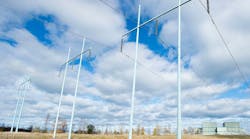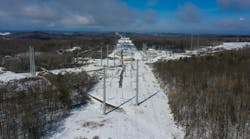With each day there seems to come another advance in technology to enhance the way we live, work and play. Developments in electric and autonomous vehicles, how we generate and use electricity, and ways to store energy are just a few of the innovations that are changing the consumer landscape.
Sounds good, right? Well, our nation's aging power grid could pull the plug on this parade of societal progress. The network of high-voltage towers and wires that crisscross the country feeding power into our communities was largely built decades ago, without today's technology developments in mind.
"We need updated and expanded energy infrastructure to support energy-intensive technologies, transport renewable energy from remote locations, and serve the related needs of customers," says Jon Jipping, chief operating officer of ITC Holdings Corp., the nation's largest independent electricity transmission company. "The quality of any state's electric grid has a profound effect on its business climate, ability to attract new jobs and support leading universities."
Supporting university research
Aside from everyday consumer demands, modern electric infrastructure is needed to support industries ranging from medical imaging to national defense. When the U.S. Department of Energy awarded Michigan State University $730 million for the new Facility for Rare Isotope Beams (FRIB) project, Dr. Wolfgang Bauer of MSU looked to ITC to support the university's growing energy-intensive research endeavors by building a new transmission substation. "We really need constant electric power and the security that comes with that on our campus all the time without exception. Just one outage and we can lose 30 years of research," says Bauer. Scheduled for completion in 2022, the FRIB will enable scientists to make discoveries about the properties of rare isotopes to advance knowledge in nuclear physics, nuclear astrophysics, fundamental interactions of nuclei, and applications of rare isotopes.
To support these and other pressing needs, ITC has spent $6.5 billion since 2003 to build new transmission lines and substations or reconstruct old power infrastructure across its seven-state footprint. The resulting improvements in system reliability, interconnections of new energy sources and access to competitive energy markets saved customers $1.4 billion between 2008 and 2014, according to an independent study. More grid modernization is needed across the country.
Moving clean energy on the wires
In addition to facilitating new technologies and industries, an updated energy grid will help fulfill the goal of tapping America's virtually unlimited renewable energy resources. As wind and solar power becomes a greater share of the country's energy mix, more power transmission line construction will be needed to carry these renewable energy sources from remote or rural areas to our cities and towns. And when the wind slows or the sun goes down, a modern energy grid will be needed to help balance these variable sources against constant sources like natural gas, coal and nuclear energy to maintain reliable service to customers.
"Let's change our mindset about how we plan the grid, and move forward with a greater sense of urgency," said Jipping. "Together with federal and state regulators, fellow utilities and other industry stakeholders, we need to bring forth constructive ways to streamline grid planning and investment to ensure a resilient grid, facilitate economic development and deliver value to customers."
Collaboration is key
Fortunately, a national conversation is underway about infrastructure, and it involves perhaps the most vital infrastructure of all: electricity. Planning the build-out of the high-voltage power transmission grid is just one piece of the energy delivery puzzle. Electricity transmission is interdependent with the planning for new power generating facilities, microgrids and other distributed energy technologies. Planning all aspects of the power flow process in concert is in the best interest of customers.
America is plugging into its energy future, with promising new demands and uses. Let's keep the national infrastructure conversation going so that the power grid can be there to support the ever-increasing demands being placed on it.



